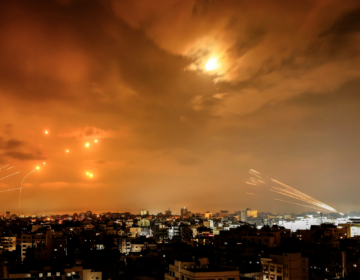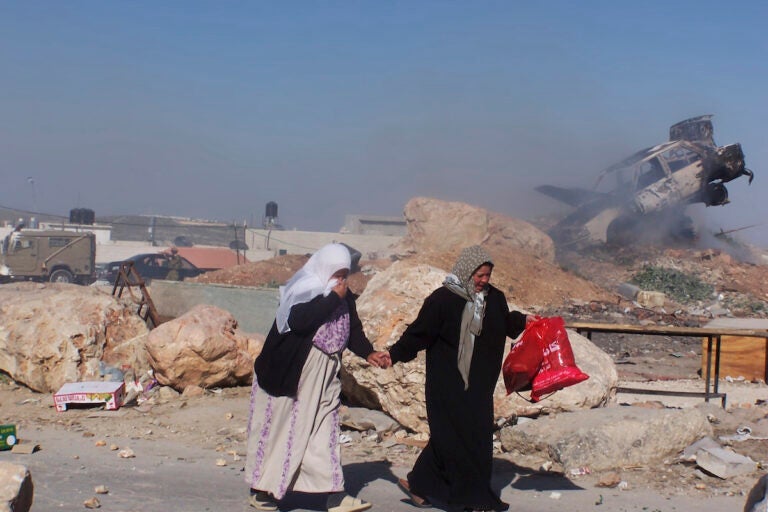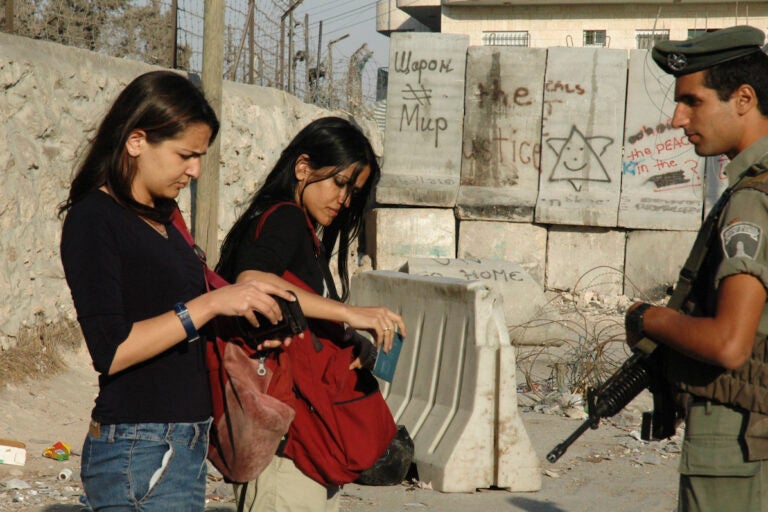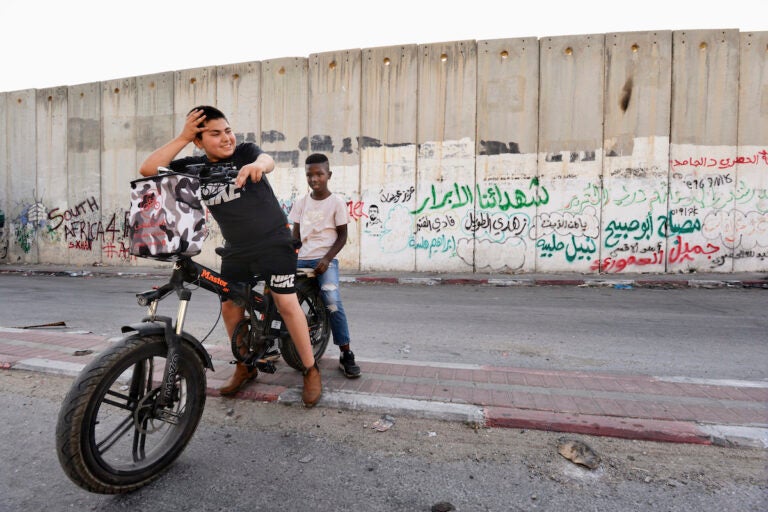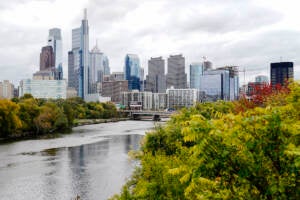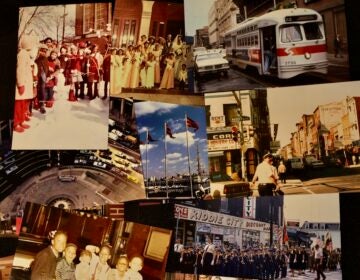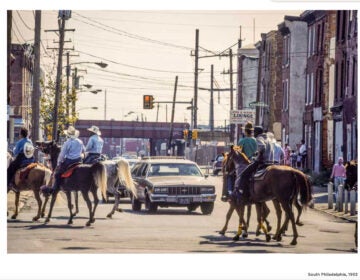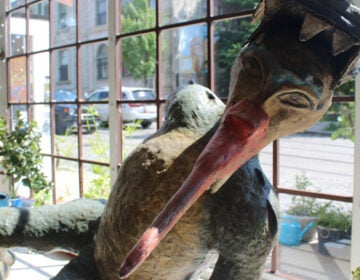20 years of Palestinian life in the West Bank on view at InLiquid gallery
The Kensington art gallery features the photography project documenting 20 years of life against the Israeli barrier wall.
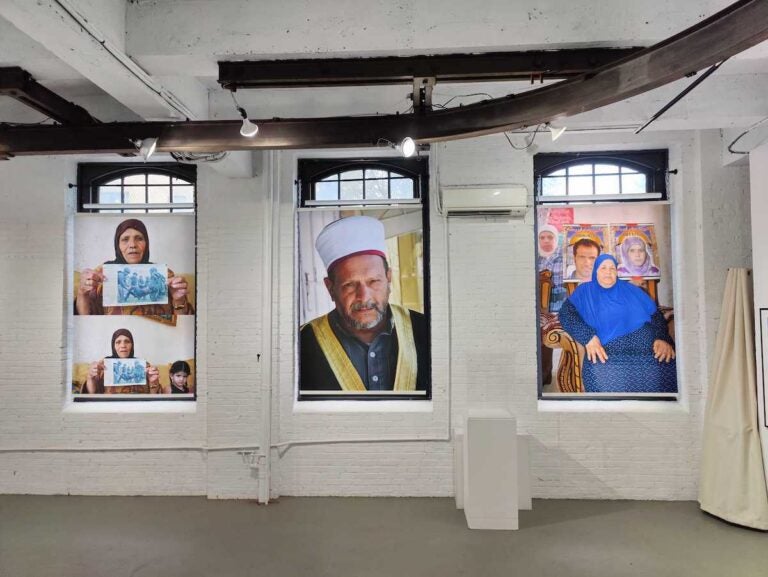
Large-scale portraits printed on scrims adorn the windows of the InLliquid Gallery. They depict Palestinians who have been demonstrating against the construction of the Israeli barrier wall for two decades. They include (L-R) a woman holding a newspaper clipping of herself being carried away by Israeli police, an Islamic judge who was attacked during a prayer protest a the barrier wall, and a mother sitting in front of portraits of her two children killed during demonstrations. (Peter Crimmins/WHYY)
From Philly and the Pa. suburbs to South Jersey and Delaware, what would you like WHYY News to cover? Let us know!
This reporting is funded by HFGF.
For 20 years, Philadelphia-based photographer Aisha Mershani has been photographing the Palestinian villages of the Israeli-occupied West Bank. She believes media coverage of Palestinians has been unbalanced, since long before the current Hamas-Israeli war.
Mershani, an assistant professor of interdisciplinary studies at Gettysburg College and media activist, has focused her lens on the 439-mile Israeli barrier wall, which segregates Palestinians from Israelis and, in some cases, Palestinians from their own land.
“Our media is biased towards Israel,” she said. “Our tax dollars are going towards the violence that the Palestinian people are experiencing. How do we come up against this gigantic system here in the U.S.? For me, this is the dent I could make.”
About 100 of her photographs are on display at the InLiquid gallery in the Crane Arts Building, in Kensington, as “La La Lil Jidar: 20 Years Behind the Apartheid Wall.” The name of the exhibition is taken from a chant often heard from Palestinians protesting the construction of the wall: “No, No To The Wall.”
Each photo is accompanied by a QR code allowing viewers to hear the subject of the photo talk about their life inside the wall.
“The struggle is about centimeters. We are fighting for each centimeter,” said Mohammed Al Khatib in an audio clip recorded in 2022. He is a leader of a movement against the construction of the wall in the West Bank village of Bil’in.
His comments accompany a 2005 photograph of himself handcuffed and shoved by Israeli police, and a 2022 photograph of himself overlooking a completed portion of the barrier wall with an Israeli settlement beyond. The exhibition describes the settlement as illegal.
“The Israelis are trying to control every centimeter of our lives,” he said. “They have the support. They have the law. If the law is against them, they will change the law for them, to make the law work for them.”
The exhibition is focused on the barrier wall in the West Bank. It does not contain any images of Gaza or Hamas, nor is it a response to the current war between Israel and Hamas. “20 Years Behind the Apartheid Wall” opened at InLiquid three weeks ago, and is based on 20 years of documentary photography.
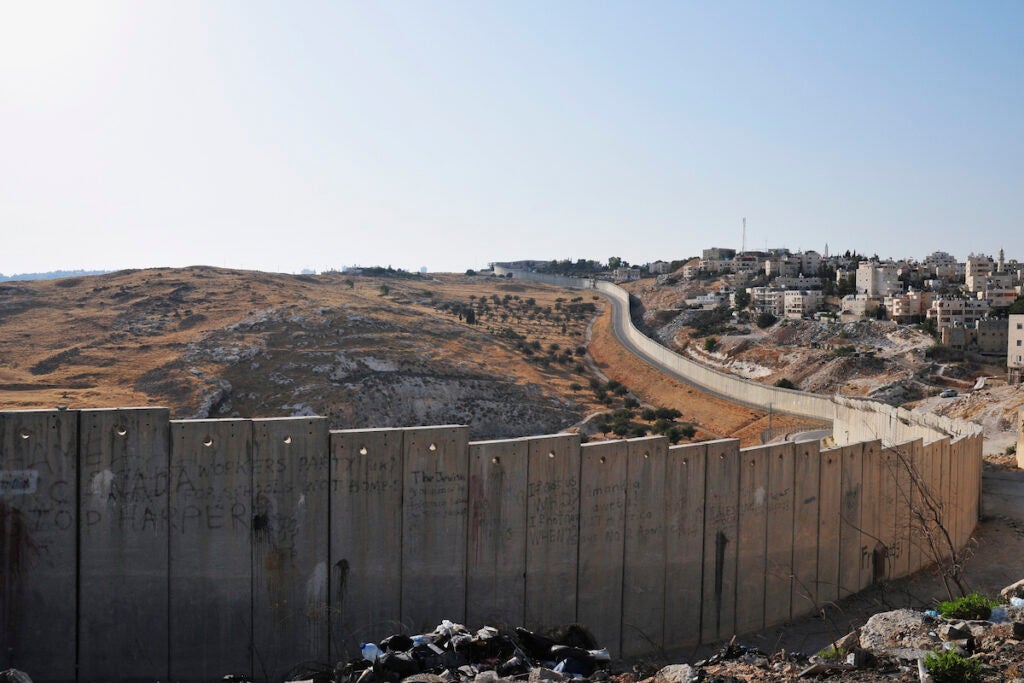
A collective of artists and activists, also called La La Lil Jidar, has formed around the photo project to tell the personal stories of Palestinians often not seen in mainstream media, in order to “shift the mainstream narrative on Palestine/Israel, while simultaneously building local community struggles through solidarity against all forms of violence,” according to its website.
The collective curated the exhibition for InLiquid. In a statement, the gallery said “La La Lil Jidar” is aligned with its mission to “encourage dialogue and work towards a culture of understanding.”
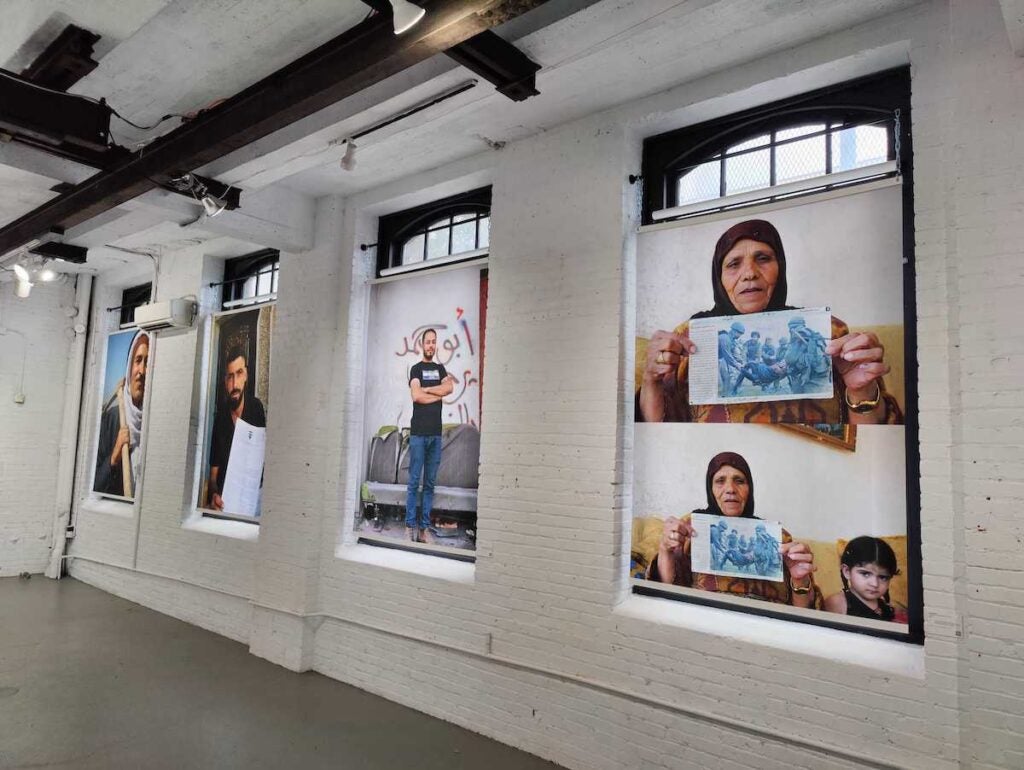
Although not directly about the current war, Mershani said the photo documentary project traces years of oppression of the Palestinian people in the West Bank, which preceded the surprise attack by Hamas in Gaza last weekend. The resulting war has killed, as of Wednesday, 1,200 people in Israel, including 14 Americans, and 950 people in Gaza. President Biden has called the Hamas attack “sheer evil.”
“Israeli families whose loved ones have been killed or taken hostage are scared. We can understand that pain and grief, and we experience that when we watch the news,” Mershani said. “Yet we are not seeing images of the grief and pain of the Palestinians inside Gaza or the West Bank. We are not seeing the indiscriminate bombing campaign or the people experiencing extreme violence on a daily basis.”
Construction of the Israeli barrier wall began in 2002 in response to suicide bombers who were crossing into Jerusalem from the West Bank. Since construction began attacks have dropped significantly, however some international observers — including the United Nations — have said the wall is “contrary to international law,” because it does not follow the accepted border between the West Bank and Israel, i.e. the Green Line, but pushes into the West Bank territory, carving space for Israeli settlements.
The wall has become a magnet for graffiti artists. The evasive artist Banksy has made several iconic images on various parts of the wall.
Mershani, who grew up Jewish in Las Vegas, Nevada, first visited Israel and the West Bank as a college student in a peace studies program. She said that even within a somewhat sheltered university program, she was able to witness peaceful demonstrations in the West Bank against the barrier wall that she never saw in the U.S. media.
“As somebody who went to a peace studies program, I was like, ‘This is amazing. This is history,’” she said. “This is everything we celebrate in Gandhi’s movement, in Martin Luther King Jr.’s movement. We celebrate when nonviolent movements are formed against violence. Yet in the Palestinian case, it was invisible to the media in the outside world.”

Mershani returned to the West Bank in 2003, to join protest actions and photograph what was happening. She returned several times over the course of two decades, seeking out the same people to photograph them again and follow their stories.
The exhibition features several now-and-then pairings. In one case the updated photo is a picture of framed pictures: two “martyr” portraits of a brother and sister, both killed by Israeli soldiers during demonstrations, propped on the couch of their parents.
The photos show a man in the Burqin village holding a demolition order informing him his house will be removed to make way for an expanding Israeli settlement. Another man explains how the construction of the barrier wall severed his home from his village, placing him in a secured military zone which forced him to pass through a military checkpoint to go home.
A large portrait of an Islamic judge Tawfik Al Amla includes an audio clip of him describing how he led a prayer during a demonstration and encountered Israeli soldiers who responded violently. One of the women portrayed explains how she was headbutted by a soldier’s rifle during a demonstration, knocking her unconscious. A photo shows her lying on the ground next to an Israeli ambulance, which refused to treat her.
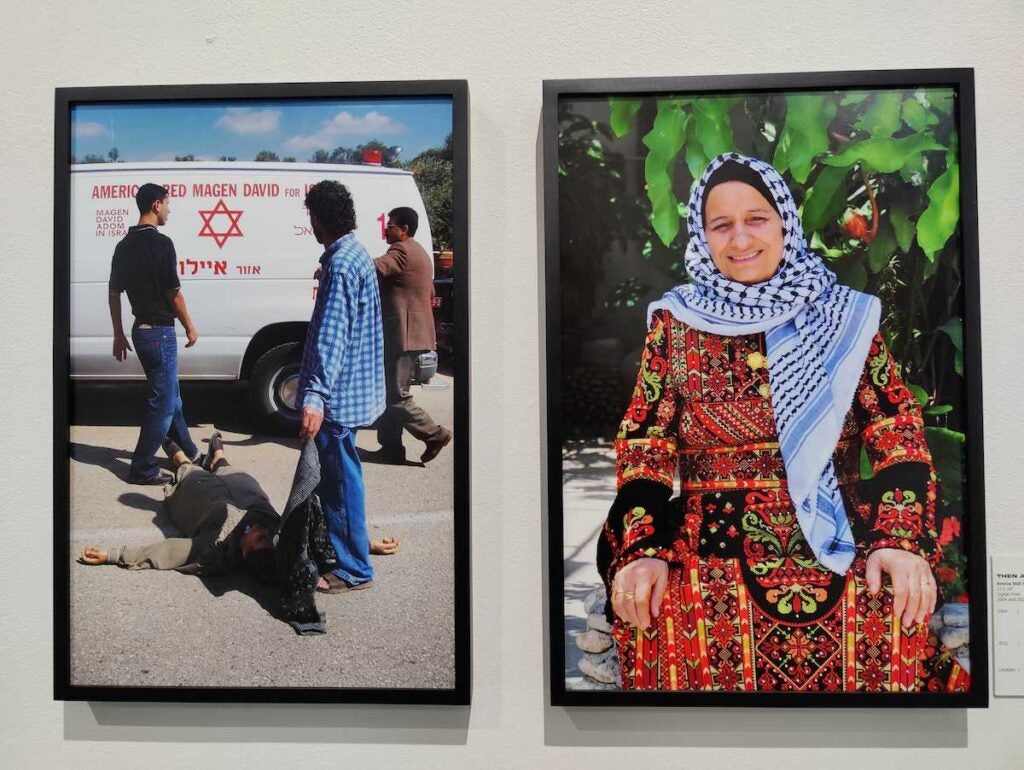
The La La Lil Jidar collective has organized a series of public events accompanying the exhibition, including a panel discussion with members of the collective, a screening of an unnamed documentary film by the Human Rights Coalition about environmental injustice in the prison system, and a live discussion, via video link, with Palestinians living in the Abu Dis village near the barrier wall.
The exhibition will be on view at InLiquid until November 11.

Get daily updates from WHYY News!
WHYY is your source for fact-based, in-depth journalism and information. As a nonprofit organization, we rely on financial support from readers like you. Please give today.



